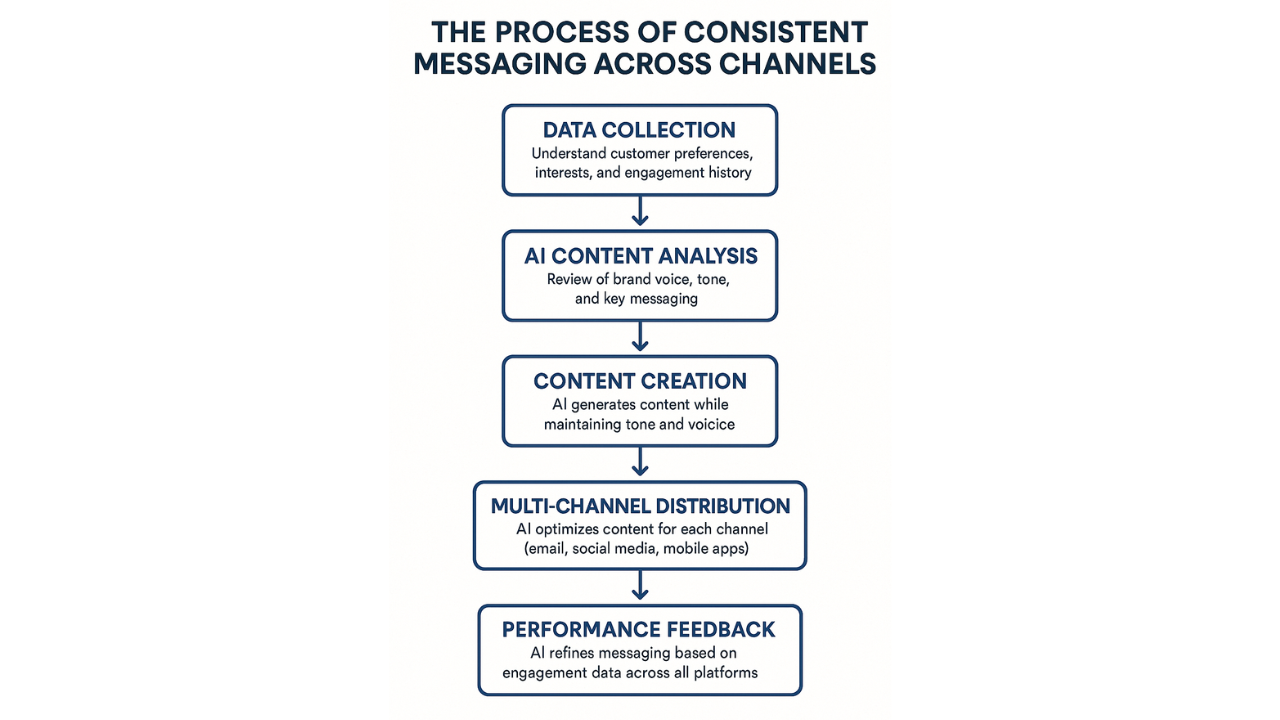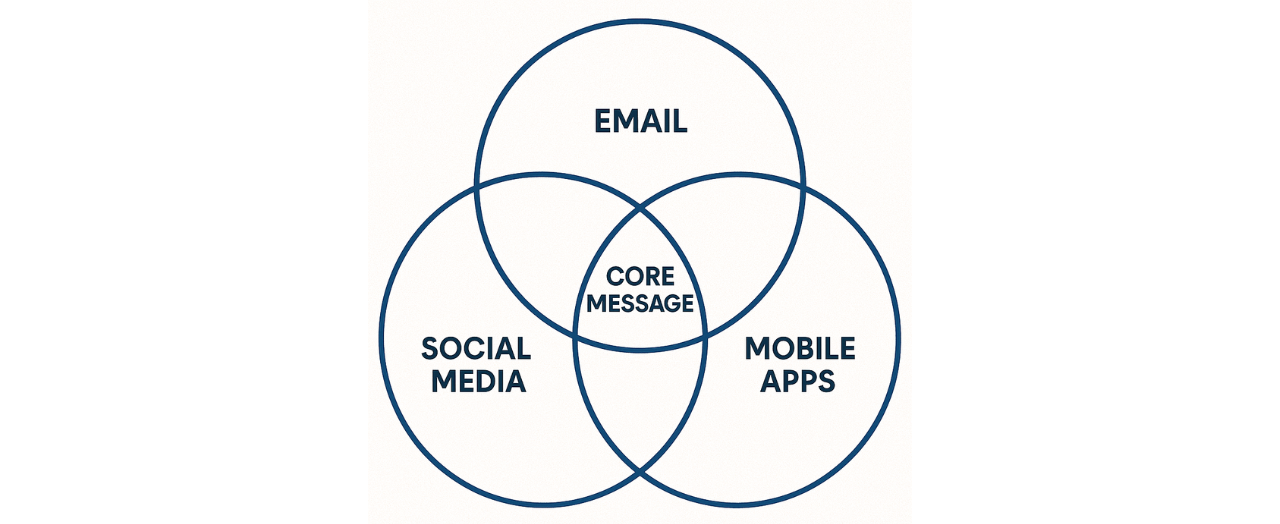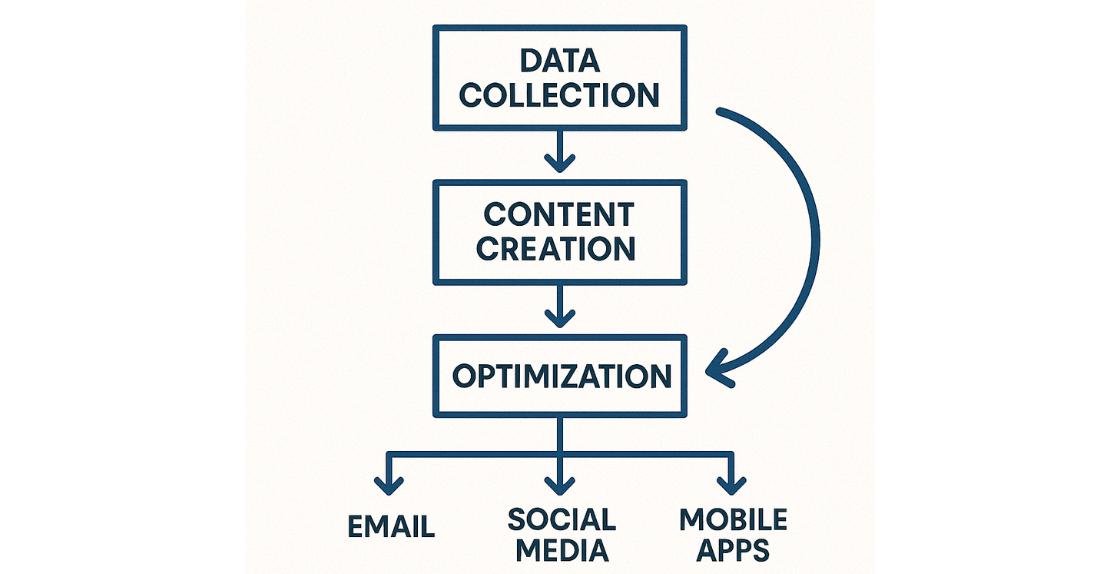In today’s digital landscape, brands must deliver a consistent experience across all touchpoints, including email, social media, and mobile apps. Inconsistent messaging not only confuses customers but can also weaken your brand identity.
AI provides a powerful solution by ensuring that messaging remains aligned across every channel. By automating content adjustments and optimising delivery, AI helps brands maintain a unified voice, improving customer trust, engagement, and overall brand recognition.

The Challenge: Maintaining Consistency Across Multiple Channels
In today’s multi-channel environment, maintaining consistent messaging across email, social media, and mobile apps can be a significant challenge for brands. With each platform having its own unique format, audience, and engagement style, it becomes difficult to ensure that your message remains aligned and unified.
The Complexities of Multi-Channel Marketing
Traditional marketing strategies rely heavily on manual content creation and distribution, which often leads to inconsistencies. For example:
- Email campaigns may be targeted and personalised, but lack the timely follow-up that social media or mobile apps offer.
- Social media posts may be highly engaging but don’t always align with email content in terms of tone or style.
- Mobile apps might send notifications, but these can often differ from email or social media messaging, creating a fragmented customer experience.
The Risks of Inconsistent Messaging
Inconsistent messaging can lead to:
- Customer Confusion: A customer who sees different messages across channels may feel unsure about the brand’s values or offers.
- Weakened Brand Identity: When messages aren’t aligned, the brand’s tone and identity can become diluted, losing its impact and recognition.
- Missed Opportunities: A disjointed experience can lead to lower engagement, fewer conversions, and diminished customer loyalty.
The Need for Unified Messaging
In order to effectively engage customers, businesses need to move away from siloed campaigns and unify their messaging across all channels. This requires an automated system that can ensure each channel delivers the same core message while adapting to the platform’s unique requirements. This is where AI-driven solutions come into play.

AI’s Role in Unified Messaging
In a world where customer expectations are higher than ever, brands need to maintain a consistent voice across multiple channels without losing the nuances of each platform. AI plays a crucial role in bridging the gap by automating and optimising content distribution, ensuring that messaging remains aligned while being tailored to each platform’s specific needs.
1. Data-Driven Personalisation
AI enables brands to gather and analyse customer data from multiple touchpoints, such as website interactions, social media engagements, and mobile app usage. By doing so, it ensures that content is not only personalised but also consistent across the board.
For instance:
- Customer Profiles: AI aggregates data from each platform to create a centralised, dynamic customer profile.
- Real-Time Analysis: AI can assess behaviour in real-time, providing insights into the customer’s journey and allowing for real-time adjustments in messaging to maintain coherence.
2. Content Management Systems (CMS) Powered by AI
AI-powered Content Management Systems (CMS) play a pivotal role in unifying messaging. These platforms allow content to be centrally managed and then automatically optimised for distribution across multiple platforms. AI can:
- Ensure Tone Consistency: AI adjusts content to maintain the same brand voice across email, social media, and mobile apps.
- Automate Updates: If there’s a change in messaging or offers, AI ensures the update is reflected across all channels simultaneously.
3. Language Processing for Tone and Context Adaptation
AI uses Natural Language Processing (NLP) to understand the tone, sentiment, and context of content. This capability is crucial for adapting messages to the unique format and audience of each platform, while still keeping the core message intact.
For example:
- Social Media: AI ensures the message is conversational and engaging, using shorter, punchy content for platforms like Twitter or Instagram.
- Email: AI may generate longer, more detailed content that aligns with a professional tone.
- Mobile Apps: Short, action-driven notifications that remain aligned with the overarching brand voice.
4. Multi-Channel Distribution
AI seamlessly integrates with multi-channel distribution tools, ensuring that the content is automatically distributed across platforms like email, social media, and mobile apps. This integration ensures that the timing, format, and tone are appropriate for each channel, all while maintaining a unified message.

The Framework: How AI Ensures Consistent Messaging
AI provides a robust framework for ensuring that messaging remains consistent across email, social media, and mobile apps. By automating content creation, analysis, and distribution, AI ensures that your brand’s voice and tone are aligned, no matter the platform. Here’s how AI achieves this across the messaging ecosystem:
1. Data Collection and Unified Customer Profiles
AI begins by collecting data across multiple touchpoints. Whether it’s customer behaviour on your website, interactions with social media posts, or in-app actions, AI gathers all of this information to create a centralised customer profile. This unified profile ensures that all channels are using the same information to personalise and optimise messages for consistency.
2. Content Creation and Messaging Consistency
Once the data is collected, AI generates content based on predefined brand guidelines (e.g., tone, voice, and messaging objectives). AI uses Natural Language Processing (NLP) to adapt the tone and language according to the platform:
- Email: Professional, detailed, and informative
- Social Media: Short, catchy, and engaging
- Mobile Apps: Actionable, concise, and timely
3. Content Optimisation and Distribution
AI ensures that content is optimised for each platform and then distributed accordingly:
- Email Campaigns: AI triggers emails based on user actions or interactions, ensuring that content is sent at the optimal time and in the right format.
- Social Media Posts: AI tailors posts to match platform-specific guidelines, using hashtags, visuals, and messaging styles that are effective for each channel.
- Mobile App Notifications: AI schedules push notifications with personalised messages based on user activity or behaviour.
AI-powered systems automatically adjust content to ensure that the core message remains intact, but the delivery is customised for each platform’s unique requirements.
4. Continuous Learning and Feedback Loops
One of the key advantages of AI is its ability to continuously learn and optimise based on real-time performance. AI tools track engagement metrics, open rates, click-through rates, social media engagement, and app interaction, and adjust future content delivery accordingly. This feedback loop ensures that messaging continues to improve over time, staying relevant and engaging.

Real-World Impact: Why Consistent Messaging Matters
For brands to stand out, ensuring consistent messaging across these platforms is not just a luxury but a necessity. AI plays a crucial role in delivering this consistency, and the results are clear. Here’s how consistent messaging powered by AI positively impacts your brand and business:
1. Enhanced Customer Trust
Consistent messaging across all platforms builds trust with your audience. When customers receive aligned, on-brand messages—whether it’s a promotional email, a tweet, or a mobile app notification—they feel that the brand is cohesive and reliable. This continuity reinforces the brand’s credibility and strengthens customer loyalty.
Example: A leading retailer that used AI to standardise its messaging across email, social media, and mobile apps saw a 15% increase in customer trust and engagement.
2. Improved Brand Recognition
When your messaging is consistent, customers begin to recognise your brand more easily. AI ensures that your voice, tone, and key messages remain aligned, helping to create a strong, memorable brand presence. Whether a customer engages via email, Instagram, or through your mobile app, they immediately recognise the brand’s identity and values.
Example: An international SaaS provider implemented AI-driven cross-channel messaging and reported a 25% increase in brand recognition in their target markets.
3. Higher Engagement Rates
When customers are consistently exposed to the same message across multiple channels, they’re more likely to engage. AI personalises content for the right audience, at the right time, on the right platform, driving higher open rates, click-through rates, and overall engagement.
Example: A financial services company integrated AI into its multi-channel marketing strategy, resulting in a 30% increase in engagement and a 20% boost in conversion rates across email and social platforms.
4. Streamlined Marketing Efforts
AI reduces the complexity of managing content across various platforms by automating content creation, distribution, and optimisation. This efficiency not only reduces the manual effort but also ensures that your messaging stays on track, saving both time and costs.
Example: A global e-commerce brand automated its content distribution using AI, which led to a 40% reduction in manual effort and a 15% reduction in content production costs.
5. Increased Conversion Rates
Consistent messaging improves customer journey alignment. When messaging across email, social media, and mobile apps aligns with customer expectations, conversion rates improve. AI ensures the seamless delivery of tailored messages, leading to higher conversion rates.
Example: A fashion brand using AI-driven, consistent cross-channel messaging saw a 10% increase in their online sales conversion rate.

Key Considerations for Implementing AI for Consistent Messaging
While AI can dramatically improve cross-channel messaging consistency, its successful implementation requires careful planning. For businesses to reap the benefits of AI-driven messaging, there are several critical factors to consider.
1. Data Privacy and Compliance
AI systems rely on customer data to create personalised and relevant messaging. However, it is essential to comply with data privacy laws such as GDPR in the EU, CCPA in California, and other local regulations. Ensuring that your data collection and processing methods are ethical and legally sound is crucial for maintaining customer trust and avoiding legal consequences.
Action Point: Ensure that customers have control over their data, with clear opt-in and opt-out mechanisms in place.
2. Training and Refining AI Models
For AI to accurately generate and distribute consistent messaging, it must be trained with high-quality, relevant data. Continual model training and fine-tuning are essential to improve AI’s predictive accuracy and its ability to adapt messaging to each customer’s preferences and behaviours.
Action Point: Regularly evaluate AI’s output and refine it based on performance metrics and feedback.
3. Platform-Specific Optimisation
Each platform (email, social media, mobile apps) requires different content formats, tone, and length. While AI ensures messaging consistency, it must also adjust content to suit platform-specific needs. AI should not only maintain consistency but also optimise each message’s delivery to match platform characteristics.
Action Point: Set clear platform guidelines for AI and ensure that the system understands the unique needs of each channel.
4. Testing and Feedback Loops
AI-generated messaging must undergo continual A/B testing to ensure effectiveness. Feedback loops help monitor customer reactions, allowing you to fine-tune messaging for greater engagement.
Action Point: Implement testing frameworks for every platform and optimise AI models based on real-time data and user feedback.
5. Maintaining Human Oversight
While AI can handle much of the heavy lifting in content creation, human oversight remains crucial to ensuring that messaging stays true to the brand’s identity and values. Human teams should review AI-generated content to ensure it aligns with the overall marketing strategy and resonates emotionally with the target audience.
Action Point: Establish a review and approval process for content to maintain quality and authenticity.
Conclusion – The Future of AI in Cross-Platform Messaging
AI has revolutionised how brands manage cross-channel messaging, ensuring consistent communication across email, social media, and mobile apps. By automating content creation, distribution, and optimisation, AI saves time, reduces costs, and boosts engagement. Moving forward, AI will only become more integral to streamlining marketing efforts and creating seamless, personalised experiences for customers.
Ready to ensure your brand’s messaging remains consistent and effective across all platforms? Let AI help you maintain one voice across all channels. Get in touch with us.


